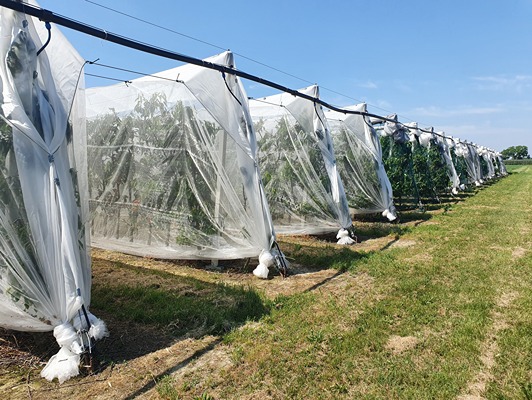Canopy shape and tree architecture are strategic elements in maximizing photosynthetic e7iciency and productivity, especially in photophilic species such as sweet cherry.
In fact, plant structure plays a fundamental role in resource-use e7iciency, as it governs carbon acquisition and water use, influencing leaf area distribution, light interception, water transport and loss, as well as carbon assimilation and allocation.
Comparison of training systems
In a recent study, Chinese researchers compared two training systems for sweet cherry using the cultivar “Jimei”: the traditional Super Slender Spindle (SSS-TS) and the innovative Yangling Inclined Trellis Arm (YLL-TS).
The objective was to assess their light interception e7iciency (LIE), fruit yield, and fruit quality, using advanced three-dimensional digitization and virtual canopy modeling techniques.
The analysis revealed that canopy structure significantly a7ects the spatial distribution of branches and leaves, leaf blade orientation, and the overall ability of the plant to capture solar radiation.
Although YLL-TS had fewer branches and a smaller total leaf area than SSS-TS, it demonstrated greater light interception e7iciency: the STAR value (a light interception index) was 48% higher in YLL-TS.
Results of simulation and measurements
This led to a more even light distribution within the canopy, due to an architecture that favors openness and a north-south orientation of the main branches.
Simulations showed that the wider angular spread of leaves in the YLL-TS system enabled more uniform radiation capture even under oblique light conditions, such as those found at mid-latitudes.
Despite SSS-TS leaves exhibiting higher values in photosynthetic parameters (net photosynthesis, transpiration, stomatal conductance) in the upper and middle canopy layers, the overall e7iciency of the plant – measured as fruit yield (kg) per square meter of leaf area – was greater in YLL-TS (1.14 kg/m2 vs. 0.79 kg/m2 in SSS-TS).
In terms of productivity per cultivated surface area, YLL-TS also performed better: due to its higher planting density, yield per square meter was significantly higher (4.075 kg/m2).
Quality vs. efficiency
However, the SSS-TS system produced slightly higher quality fruits in terms of size (average weight of 11.05 g vs. 8.11 g), soluble solids (18.33 vs. 15.64 °Brix), and skin brightness, likely due to greater assimilate availability per fruit.
These di7erences in visual and nutritional quality may be important depending on the grower’s market goals, but they do not diminish the greater e7iciency of the YLL-TS system in high-intensity production scenarios.
Conclusions on canopy management
In conclusion, the application of 3D reconstruction and virtual modeling technologies has provided deeper insight into the relationship between plant architecture, light interception e7iciency, photosynthetic e7iciency, and yield.
Although some fruit quality traits showed slight declines, the Yangling Inclined Trellis Arm system proved to be a well-suited solution for intensive sweet cherry cultivation, especially where a balance between yield per area and rational canopy management is desired.
Source: Zhang, J., Xu, W., Dou, Z., Pan, L., Wan, T., An, F., Zhifang, Y., & Cai, Y. (2025). E7ect of Yangling inclined trellis tree shape on light interception e7iciency, fruit quality, and yield of sweet cherry cv: ‘Jimei’. PloS one, 20(3), e0317101. https://doi.org/10.1371/journal.pone.0317101
Image source:Zhang et al., 2025
Andrea Giovannini
University of Bologna (ITA)
Cherry Times - All rights reserved












